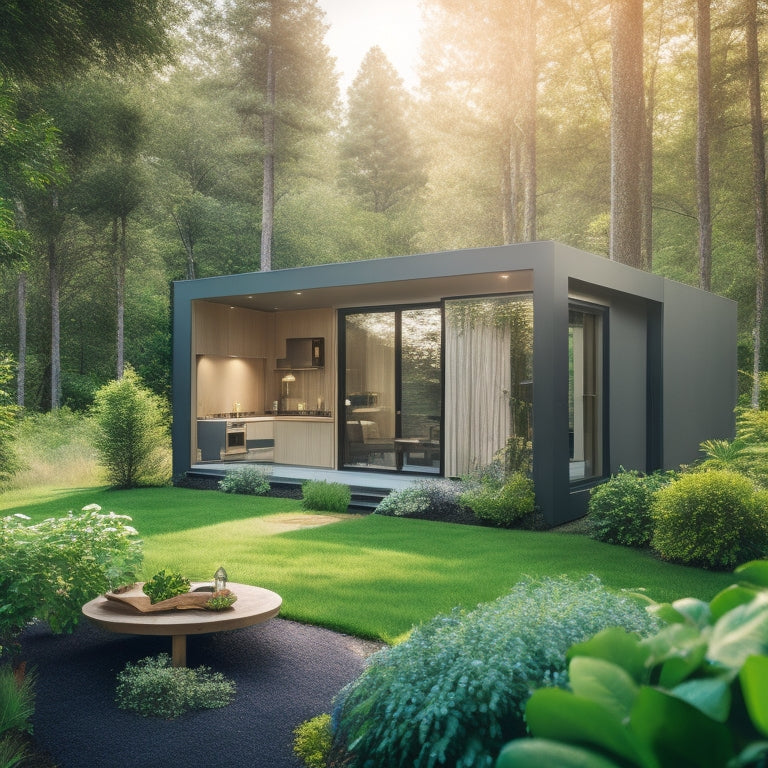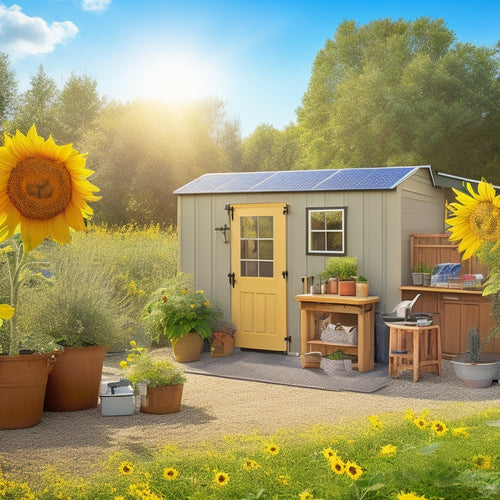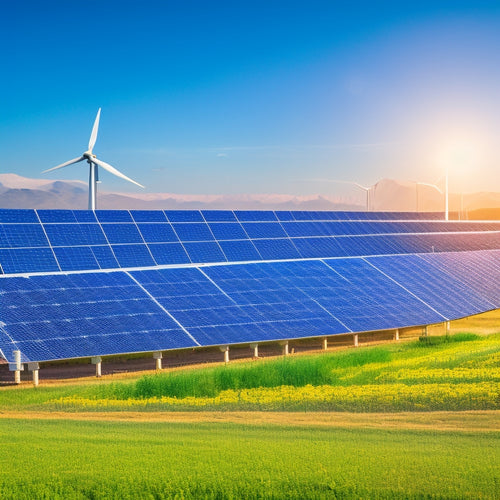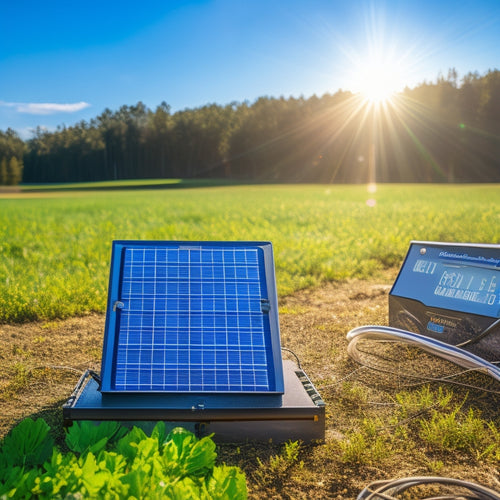
What Makes Small Homes Highly Efficient?
Share
You're likely to be drawn to small homes due to their eco-friendly reputation, but what you might not know is that their efficiency stems from a combination of deliberate design choices, state-of-the-art materials, and smart technologies that work together to minimize waste and maximize resource utilization. Compact designs and layouts, energy-efficient building materials, and smart home automation systems all contribute to this efficiency. Additionally, space-saving appliances, water conservation strategies, and renewable energy integration help reduce energy consumption and environmental impact. As you investigate the complexities of small home design, you'll uncover a wealth of opportunities to optimize every aspect of your tiny abode.
Key Takeaways
- Compact design and layout incorporating multi-functional furniture and open floorplans enhance space efficiency and natural light.
- Energy-efficient building materials, such as sustainable and recycled materials, improve indoor air quality and reduce reliance on non-renewable energy.
- Proper insulation, weatherization, and air sealing prevent energy loss and maintain consistent indoor temperatures.
- Smart home automation systems with energy monitoring and remote controls enable real-time energy tracking and optimization.
- Space-saving appliance selection, water conservation strategies, and renewable energy integration reduce energy consumption and environmental impact.
Compact Design and Layout
Optimize your small home's functionality by strategically planning its compact design and layout. A well-designed layout can greatly impact your daily living experience.
By incorporating multi-functional furniture, you can maximize space efficiency while minimizing clutter. To guarantee a reliable energy supply, consider assessing energy needs and selecting high-efficiency solar panels with a 25-year performance warranty.
Open floorplans can also help to create a sense of spaciousness, making your home feel larger than it is. Consider a layout that combines living, dining, and kitchen areas to create a seamless flow.
This design approach can also help to reduce the number of walls and doors, increasing natural light and airflow. By carefully planning your compact design and layout, you can create a functional and comfortable living space that meets your needs.
Energy-Efficient Building Materials
As you construct your small home, selecting the right energy-efficient building materials is vital to reducing your carbon footprint and saving on utility bills.
You'll want to prioritize sustainable sourcing, incorporating recycled materials whenever possible. This not only reduces waste but also conserves natural resources.
Consider passive design principles, such as natural ventilation and thermal mass, to minimize the need for mechanical systems. Low-VOC (volatile organic compound) paints and finishes guarantee better indoor air quality.
By incorporating solar-powered systems, such as solar shelving functionality, you can further reduce your reliance on non-renewable energy sources.
Additionally, compost recycling and rainwater harvesting can also be applied to your small home to reduce waste and conserve water.
Durable finishes and eco-friendly coatings prolong the lifespan of your materials. Additionally, choose regional materials to reduce transportation emissions.
Insulation and Weatherization
You've selected sustainable building materials for your small home, now it's time to guarantee those materials perform at their best by focusing on proper insulation and weatherization. This vital step assures your home's thermal performance, preventing energy loss and maintaining a comfortable living space.
Proper energy management, such as off-grid solar power systems, can also greatly reduce energy needs. Additionally, careful selection of solar panels, like those used in off-grid systems, can maximize energy reliability.
To achieve peak insulation and weatherization, consider the following:
- Air sealing and moisture management to prevent heat transfer and water damage
- Selecting the right insulation types and materials based on climate considerations and passive design principles
- Implementing weatherproofing techniques to prevent air leaks and water intrusion
- Draft prevention measures to maintain a consistent indoor temperature and humidity level
Smart Home Automation Systems
You can optimize your small home's energy consumption with smart home automation systems that integrate energy monitoring systems, which track your energy usage in real-time, allowing you to identify areas for improvement.
These systems also provide streamlined remote controls, enabling you to adjust your home's temperature, lighting, and appliances from a single interface.
Energy Monitoring Systems
One of the most effective ways to optimize energy efficiency in small homes is by installing an energy monitoring system, an essential component of smart home automation.
This system provides you with real-time data on your energy usage, helping you identify areas of inefficiency. With monitoring tools, you gain behavioral understanding that allows you to make informed decisions about your energy consumption.
-
Real-time data on energy usage helps you track performance and identify opportunities for improvement.
-
Behavioral understanding enables you to change your energy consumption habits, leading to cost savings.
-
System integration enables seamless monitoring and control of your energy usage.
- User engagement features encourage you to take an active role in optimizing your energy efficiency.
Streamlined Remote Controls
Beyond the domain of energy monitoring, streamlined remote controls emerge as a vital component of smart home automation, allowing you to effortlessly govern your small home's functions from a single, intuitive interface. These systems provide user-friendly interfaces, ensuring easy maneuvering and control of various devices. With multi-device compatibility, you can seamlessly integrate devices from different manufacturers, creating a harmonious and efficient living space.
| Feature | Description | Benefit |
|---|---|---|
| Voice Control | Control devices using voice commands | Hands-free convenience |
| Remote Access | Monitor and control devices from anywhere | Increased flexibility |
| Automation Schedules | Pre-set schedules for device automation | Energy efficiency and convenience |
| Customization | Personalize device settings and scenes | Enhanced user experience |
Space-Saving Appliance Selection
Efficiency converges with innovation in the domain of space-saving appliances, where compact designs and clever engineering redefine the notion of functional living.
You'll find that selecting appliances with a focus on space-saving design allows you to optimize your home's functionality.
-
Look for appliances with multi-functional features, such as a microwave-toaster oven combo, to reduce the number of devices taking up useful space.
-
Consider installing vertical storage solutions, like a wall-mounted foldable table or a retractable clothesline, to maximize your home's vertical space.
-
Choose compact, energy-efficient models of essential appliances, such as a mini refrigerator or a low-flow dishwasher.
- Don't forget to measure your space carefully to guarantee the appliances you select fit comfortably, allowing for easy movement and minimal clutter.
Water Conservation Strategies
You can considerably reduce your water consumption by installing low-flow fixtures, which use 20-30% less water than traditional fixtures.
Additionally, grey water systems can be implemented to reuse water from sinks, showers, and washing machines for irrigation and flushing toilets, further minimizing your water usage.
Low Flow Fixtures
Install low-flow fixtures to slash your water consumption, and you'll be doing the environment - and your wallet - a favor.
These fixtures use considerably less water than traditional ones, reducing your water bill and conserving this precious resource. By incorporating low-flow toilets, high efficiency faucets, and aerator technology into your plumbing upgrades, you can make a substantial impact.
-
Look for fixtures with the WaterSense label, which indicates they meet EPA standards for water efficiency.
-
Consider replacing old toilets with low-flow models, which use an average of 1.28 gallons per flush.
-
Install high-efficiency faucets with aerator technology, which can reduce water flow to 1.5 gallons per minute.
- Educate yourself on proper leak detection and maintenance to guarantee your low-flow fixtures operate at peak efficiency.
Grey Water Systems
Grey water systems, which reuse water from sinks, showers, and washing machines for irrigation and flushing toilets, offer a promising water conservation strategy.
By adopting grey water systems, you can markedly reduce your water consumption and lower your water bills. The grey water benefits include sustainable landscaping, reduced water recycling, and a decreased environmental impact.
However, it's important to comply with plumbing regulations and follow proper maintenance practices to guarantee the system's efficiency. Treatment methods, such as filtration and disinfection, are essential to prevent contamination.
System integration with your existing plumbing infrastructure is also critical. Although installation costs may be high, the long-term benefits make it a worthwhile investment.
Renewable Energy Integration
Utilizing renewable energy sources is essential in creating an efficient small home.
You'll want to evaluate various options to maximize energy harvesting and reduce your reliance on the grid.
-
Optimize solar panel placement to capture the most sunlight throughout the day.
-
Investigate wind turbine options, assessing factors like noise levels and aesthetics.
-
Research energy storage solutions, such as batteries, to store excess energy for later use.
- Incorporate passive solar design principles, like large south-facing windows, to utilize natural heat and light.
Frequently Asked Questions
Can Small Homes Be Customized to Fit Individual Needs and Styles?
You can tailor small homes to fit your unique needs and style by leveraging design flexibility, which allows for personalized spaces that cater to your lifestyle, preferences, and habits, ensuring a perfect blend of form and function.
How Do Small Homes Address Noise Reduction and Soundproofing?
You'll find that small homes effectively address noise reduction and soundproofing by incorporating acoustic materials and sound insulation, strategically placing them in walls, floors, and ceilings to minimize echo and external noise, creating a quieter living space.
Are Small Homes More Prone to Pest and Rodent Infestations?
You might wonder if small homes are more susceptible to pest and rodent infestations due to their compact design, but implementing proactive pest control measures, such as sealing entry points and using rodent prevention systems, can mitigate these risks.
Do Small Homes Require Special Permits or Zoning Variances?
As you steer through the tiny home trend, you'll find that obtaining special permits or zoning variances is often a hurdle; however, by understanding local building codes and land-use regulations, you'll be better equipped to overcome these obstacles and break ground on your compact abode.
Can Small Homes Be Expanded or Added Onto in the Future?
You'll find that small homes can be expanded or added onto in the future, thanks to modular design, which allows for easy future expansion, making it an attractive option for those who want to scale up without sacrificing efficiency.
Related Posts
-

Building an Emergency Backup Solar Power System in 5 Essential Steps
Building an emergency backup solar power system involves five key steps. First, assess your daily energy needs to ide...
-

The Role of Battery Monitoring Systems in Renewable Energy
Battery monitoring systems play an essential role in renewable energy by enhancing system longevity and optimizing pe...
-

Choosing the Right Solar Power Charge Controller
Choosing the right solar power charge controller is crucial for maximizing energy efficiency and extending battery li...


